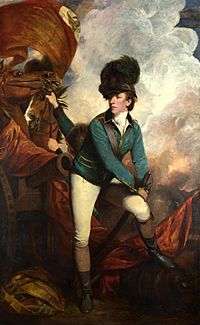Battle of Fishing Creek facts for kids
Quick facts for kids Battle of Fishing Creek |
|||||||
|---|---|---|---|---|---|---|---|
| Part of the American Revolutionary War | |||||||
 Lieutenant-Colonel Banastre Tarleton by Sir Joshua Reynolds |
|||||||
|
|||||||
| Belligerents | |||||||
| Commanders and leaders | |||||||
| Strength | |||||||
| 100 regulars 700 militia 2 guns |
160 regulars and militia | ||||||
| Casualties and losses | |||||||
| 150+ killed 300 captured |
16 killed and wounded | ||||||
The Battle of Fishing Creek, also known as the Battle of Catawba Ford, was an important fight during the American Revolutionary War. It happened on August 18, 1780, in South Carolina. British forces, led by Banastre Tarleton, surprised American militia soldiers under Thomas Sumter. Many American soldiers were killed or captured. Sumter himself barely escaped.
Contents
Why the Battle of Fishing Creek Happened
British Plans in the South
After a big victory in May 1780, the British felt good about their plan. They wanted to take back control of the southern United States. Lord Cornwallis was the British commander in the south. He set up British and Loyalist bases. Loyalists were American colonists who supported the British King. These bases were all over South Carolina and Georgia.
American Fighters Emerge
With no regular American army units around, local leaders stepped up. Men like Francis Marion, Andrew Pickens, and Thomas Sumter formed groups of militia. Militia were citizen soldiers, not full-time soldiers. They started fighting back against the British. Sumter was very successful in the northern part of South Carolina. He attacked British bases at Rocky Mount and Hanging Rock.
New Threats and Big Battles
In August 1780, a new American army formed in North Carolina. General Horatio Gates led this army south. He wanted to challenge the British base at Camden, South Carolina. Lord Cornwallis sent more troops to Camden. Meanwhile, Sumter helped by attacking British supply lines. On August 16, Gates's army met Cornwallis's army near Camden. The Americans suffered a huge defeat in the Battle of Camden.
Sumter's Mistake
Just one day before the Camden battle, Sumter had captured British supplies. He also took many prisoners. His group was moving slowly north. When he heard about the disaster at Camden, he should have been more careful. But Sumter did not take basic safety steps. His group stopped to rest near Fishing Creek on August 17. After his victory, Cornwallis ordered Banastre Tarleton to find Sumter. Tarleton led a group called the British Legion, which included Loyalists.
The Battle of Fishing Creek
Tarleton's Pursuit
Tarleton and about 350 men left the main British army. They went to Rocky Mount, thinking Sumter was there. But Sumter had already moved north. He had crossed the Catawba River. Tarleton quickly followed him the next morning. He reached Sumter's old camp, but Sumter had moved again. Tarleton picked 160 of his fastest men. He left the rest to guard his rear. He kept chasing Sumter. Finally, he caught up with Sumter at Fishing Creek.
The Surprise Attack
Sumter had placed guards around his camp. But Tarleton's men were too fast. They quickly overpowered the guards. The guards could not warn the camp. Tarleton's cavalry (soldiers on horseback) charged into Sumter's camp. The American soldiers were completely unprepared. The British quickly took control of their weapons. Sumter himself was sleeping under a wagon. He barely managed to escape in the chaos.
What Happened After the Battle
Tarleton freed the British prisoners Sumter had taken. He also got back all the supplies Sumter had captured. About 300 of Sumter's men were taken prisoner.
Sumter arrived in Charlotte, North Carolina, two days later. He was alone. But he didn't give up. He eventually gathered his militia again. Sumter later got some revenge against Tarleton. This happened at the Battle of Blackstock's Farm in November 1780. Sumter was wounded early in that battle. But another American leader, Colonel John Twiggs, took over command.

